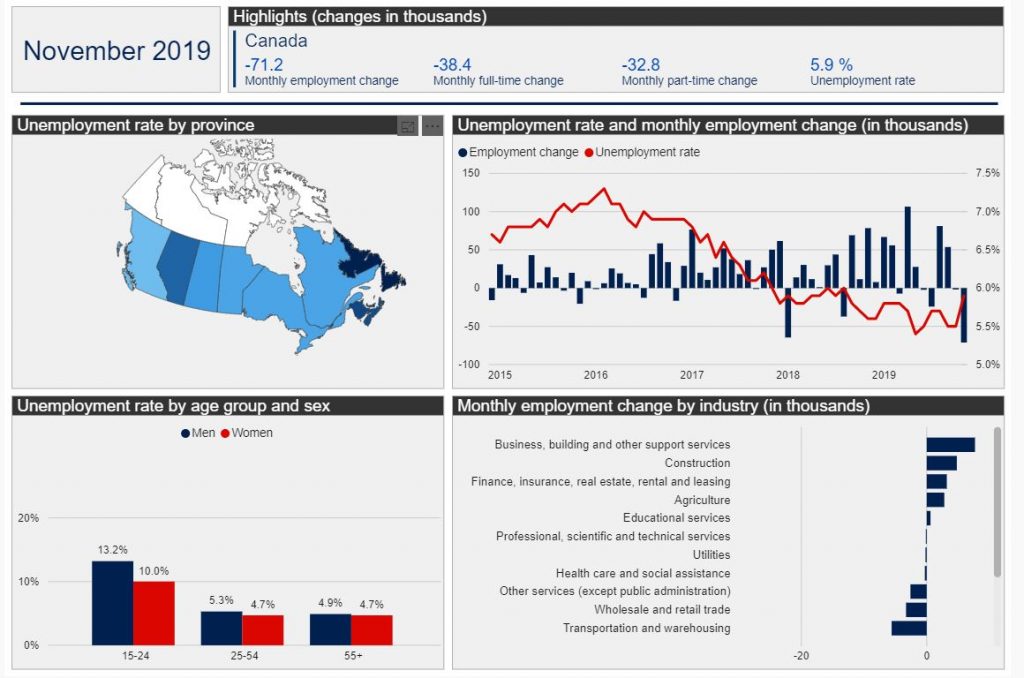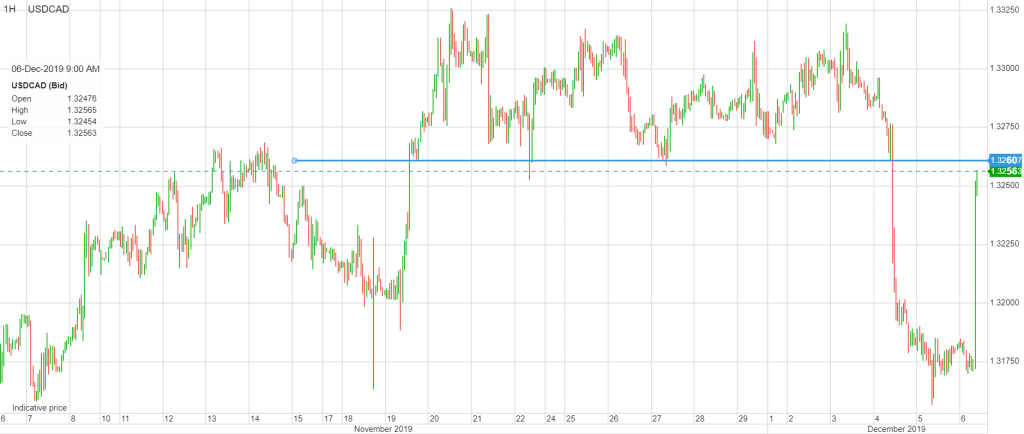
December 6, 2019
USDCAD open 1.3179-82 (6:00 am EST) Overnight range 1.3166-1.3255
That splat you heard. It was the Loonie flying full speed into the windshield of an NFP-Canada Labour semi-truck. USDCAD spiked to 1.3255 from 1.3175 after Stats Canada said Canada lost 71,200 jobs in November and the unemployment rate jumped to 5.9% from 5.5%. Even worse, US jobs surged higher Nonfarm payrolls rose 266,000 and year over year hourly earnings rose to 3.1%. The October earnings report was revised higher to 3.2%.
The US dollar rallied across the board, post-NFP but the gains have been marginal (other than against CAD) as the data will not change the Fed’s monetary policy outlook. Fed Chair Jerome Powell said that the US economy was in a good place, and today’s data just confirmed his view.
FX Market Snapshot
Change in currency value against the US dollar from NY close to NY open

Source: Saxo Bank/IFXA
At first glance, the Canadian employment report is a pig. It doesn’t get much better after the second glance, either. Newfoundland and Labrador as well as Nova Scotia and Alberta have the highest unemployment rates. Stats Canada noted that “compared with November 2018, employment gains totalled 293,000 (+1.6%), with the increase largely accounted for by full-time work. Over the same period, total hours worked grew by 0.2%.”
Canada employment report at a glance

Source: Statistics Canada
Aerosmith summed up overnight FX markets in one line: “It’s the same old story, same old song and dance.” Trump’s comments on US-China trade, China’s rebuttal to said comments, and UK election concerns took turns on center-stage. The ongoing Opec meeting was another main attraction. There are reports that the Cartel agreed to cut oil production by an additional 500,000 barrels/day, until the end of March 2020. They still need approval from non-Opec countries.
There are signs of progress around the US/China trade talks. China said it would waive tariffs on some imports of American soybeans and pork. The news follows President Trump’s comment that “something could happen with regards to tariffs on December 15.”
EURUSD hovered around 1.1100, as weaker than expected German October Industrial Prices (actual -1.7% vs forecast 0.1%) limited topside gains. The news stoked renewed German recession fears. There are reports of around $1.1 billion of 1.1100 option strikes maturing this morning which are stifling trade.
GBPUSD dropped from 1.3163 in Asia to 1.3112 in early European trading, in part due to profit-taking after the rally in the previous 48 hours. Prices rebounded after a report that the Halifax House Price Index rose 1.0% compared to forecasts for a 0.7% decline.
USDJPY drifted lower overnight, falling from 108.77 to 108.58 where it opened in New York. Prices were weighed down by softer US Treasury yields, with a bit of GBPJPY demand thrown in.
The improved China/US trade rhetoric underpinned AUDUSD and NZDUSD. Kiwi got an added boost from comments by RBNZ Deputy Governor Geoff Bascand, suggesting the New Zealand economy may be close to a turning point.
The US Michigan Consumer Sentiment Index for December is expected to dip to 96.6 from 96.8 in November.
USDCAD Technical View
The intraday technicals are bearish below 1.3190, looking for a break of 1.3150 to extend losses to 1.3110. A break above 1.3190 risks a retest of 1.3260 and then 1.3310. The 2019 downtrend from January is intact while prices are below 1.3350 while long-term support comes into play in the 1.3040-90 area.
For today, USDCAD support is at 1.3150 and 1.3110. Resistance is at 1.3205 and 1.3240. Today’s Range 1.3180-1.3260
Chart: USDCAD 1 hour

Source: Saxo Bank





